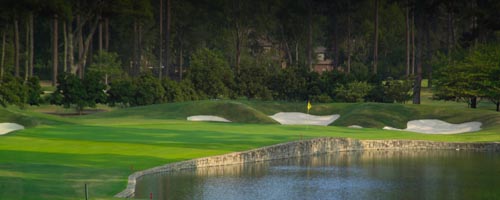
Atlanta Athletic Club's par-three 15th hole is creating some controversy. Photo courtesy of Atlanta Athletic Club.
The 260-yard par-three 15th hole at Atlanta Athletic Club is driving the pros crazy this week. So crazy that they aren’t thinking clearly.
It’s a fair point to debate whether the size and shape of the green and the positioning of the water hazard abutting the right side and right front of the green are appropriate for the length of the hole—even taking into consideration that it’s downhill and most days is not set up to play its maximum yardage.
But the criticism has gone far beyond that into shaky territory. For example, while many have pointed out that quite a few of the great par threes in the world are short ones, I’ve seen at least a couple people who said that all great par threes are short. Um, the 16th at Cypress Point (which many consider the best hole in the world)? The fifth at Pine Valley?
I’ve also read about players saying there is “no bail-out” and “if you don’t hit it solid, you’re in the water.” Actually, if you keep it on the left side, you’re dry.
And Luke Donald said that such a long par three “takes the skill out.” But a fairway wood or long iron is harder to hit than a short or middle iron. In other words, it takes more skill to hit a good one.
Those were the “pre-mortems,” so to speak, and there was also some curious commentary on Thursday when, by the way, the hole was the second toughest on the course as it played to about a 3.4 average.
Tiger Woods came to the 15th at 3-under through five holes, having started on the back nine. His round turned permanently in the wrong direction when he hit a long-iron tee shot into the water on 15 and double bogeyed (he played the last 14 holes in 10-over and shot a 77).
After the round, Woods said that after getting off to such a good start he decided to forget mechanics and play by feel. He further explained that he was trying to shape shots, but instead was hitting them straight, and he pointed to the 15th hole as an example of a ball that didn’t move.
Are we to really believe that Woods decided to aim at the water and draw the ball back to the green? That’s a shot selection that makes little sense. In any case, Woods hit a poorer shot than he described: Even if it had been on line it would have come up short, which means it was not struck well.
Phil Mickelson, after shooting a 71, included the 15th in his blanket criticism of the par-threes on the course. They are fine for the PGA Championship, he said, but too hard for the members. That’s certainly a fair point. Even from the shorter distance of the member tees, it’s a real challenge for mid- and high-handicappers to have to fly the ball over water to all four greens, three of them with the water guarding the greens very closely.
I agree with Mickelson’s complaint about too many forced carries for the average golfer in much modern architecture. But he was off base in blaming it on “the guy who redid this [course],” that is, Rees Jones, who Mickelson has a history of criticizing. The par threes at Atlanta Athletic Club have been the same in their essence, requiring long carries over water, since they were designed by Robert Trent Jones (Rees’ father) and Joe Finger in 1967 and 1971, architects of the two nines that make up the Highlands Course. It’s possible that an early redesign by George and Tom Fazio in 1973-75 played a role, but the footprint of the holes is basically unchanged since the time of the 1976 U.S. Open. Rees Jones rebuilt the greens and changed some of the bunkering in his 1995 and 2006 redesigns, but the par threes were ball-gobblers long before that.
Back when Atlanta Athletic Club was hosting the 1976 U.S. Open and 1981 PGA Championship, I didn’t like the par threes at all. They were a big reason I considered it a challenging but unimaginative course. You have one par three playing over water guarding the left and left front, another playing over water guarding the right and right front, another playing over water stretching across the entire front of the green. I guess that’s variety, in a way, but it’s a cookie-cutter sort of variety.
Today I like those holes a little better in the overall context of the course, at least for the pros, and here’s why. Even stretching the layout to 7,467 yards, the pros are hitting short irons into most of the par fours and reaching both par fives in two thanks to the driving distances in today’s game (90-degree heat also helps). That leaves it up to the par threes to provide the most challenge. So, forcing the pros to hit a difficult target with a long iron or hybrid, as they have to do at the 15th, sort of balances things out.
And, apparently, drives them a little batty.
